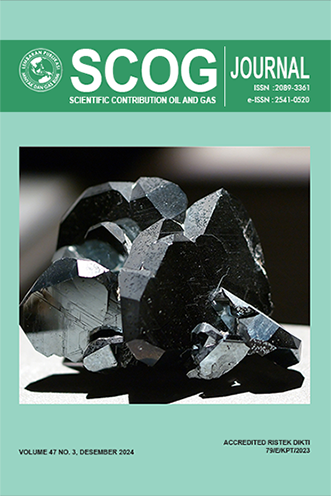The Characteristics of Sapindus Rarak Green Surfactant Injection to Enhance Oil Recovery
DOI:
https://doi.org/10.29017/SCOG.47.3.1637Keywords:
biosurfactant, Sapindus Rarak, salinity, surfactant injection, recovery factorAbstract
Green surfactants are surfactants derived from natural materials such as plants, animals, and microorganisms. Sapindus Rarak contains saponins, one type of natural surfactant that is widely known. This study evaluated the effectiveness of surfactant injection using Sapindus Rarak. This study involved laboratory experiments and analytical design with variations in salinity of 6,000 and 10,000 ppm and six variations of Sapindus Rarak surfactant concentrations from 0.5% to 3.0% using Berea sandstone cores at a temperature of 60℃. Compatibility testing based on water stability and phase behavior tests showed that only three samples of surfactant solutions, namely Sapindus Rarak surfactant concentration of 2.0% at a salinity of 6,000 ppm and surfactant concentrations of 2.5% and 3.0% at a salinity of 10,000 ppm, were homogeneous. The two best samples were selected based on the largest middle phase emulsion volume for each salinity, namely Sapindus Rarak surfactant concentration of 2.0% at a salinity of 6,000 ppm and surfactant concentration of 2.5% at 10,000 ppm. The wettability test of the two selected samples showed strongly water wet properties with contact angles of 26.86° and 23.28°, respectively. The results of the interfacial tension (IFT) test for the two selected samples were 2.15 x 10-1 and 1.71 x 10-1 mN/m, respectively. Based on the thermal stability test, the IFT values after 12 weeks for the two selected samples were smaller, namely 5.81 x 10-2 and 1.51 x 10-1 mN/m, respectively. Oil recovery factor (RF) for water injection showed that the use of 6,000 ppm salinity was better than 10,000 ppm salinity, which were 35.35% and 25.00%, respectively, while for surfactant flooding, the RF for the two selected Sapindus Rarak solution samples were 14.14% and 23.49%, respectively. This study offers a great opportunity to include green alternatives to improve conventional chemical-enhanced oil recovery techniques.
References
Alli, Y. F., Tobing, E. M., & Usman, U., 2018, Microemulsion flooding mechanism for optimum oil recovery on chemical injection. Scientific Contributions Oil and Gas, 40(2), 85–90. https://doi.org/10.29017/scog.40.2.43.
Artha, I. W. W., Hendrayana, M. A., Dewa, I., & Sukrama, I. D. M., 2022, uji daya hambat ekstrak etanol buah lerak (Sapindus Rarak) terhadap bakteri Staphylococcus epidermidis. Jurnal Medika Udayana, 11(5), 14-18. https://doi.org/10.24843.MU.2022.V11.i5.P03
Darwis, K., 2021, Counseling on the Use of Soap Nuts (Sapindus Rarak) as an Environmentally Friendly Alternative to Soap for Housewives in Makassar City. Mega Pena: Jurnal Pengabdian Kepada Masyarakat, 1(1), 7-11. https://doi.org/10.37289/mp.v1i1.8
Budhya, E. F., Fathaddin, M. T., & Kasmungin, S. (2018). Production of Bagasse-Based Natrium Ligno Sulfonat (Nals) Surfactant for Chemical Flooding. Journal of Earth Energy Science Engineering and Technology, 1(2), 49-54. https://doi.org/10.25105/jeeset.v1i2.3940.
Fatimah, S., Arifan, F., Herdiyanto, A. A., Rezky, M., & Ramadhani, C., 2020, Research on CV. Rena Soap Nut Detergent as Future Organic Detergent in Indonesia. IOP Conference Series: Earth and Environmental Science, 448, 012111. https://doi.org/10.1088/1755-1315/448/1/012111.
Febrian, A. N., Wahyuni, M. G. S., & Satiawati, L., 2015, Studi Laboratorium Pengaruh Penggunaan Fluida Komplesi CaBr 2 Terhadap Sifat Fisik Batuan Sandstone Sintetik. Seminar Nasional Cendekiawan 2015, Jakarta, Indonesia. https://doi.org/10.25105/semnas.v0i0.221.
Gbadamosi, A.O., Junin, R., Manan, M.A. Agi, A., & Yusuff, A. S., 2019, An overview of chemical enhanced oil recovery: recent advances and prospects. Int Nano Lett 9, 171–202. https://doi.org/10.1007/s40089-019-0272-8.
Hajimohammadi, R., Hosseini M., Amani H., & Darzi G. N., 2017, Experimental design procedure for optimization of saponin extraction from Glycyrrhiza glabra: A biosurfactant for emulsification of heavy crude oil. Tenside Surfactants Detergents., 54, 308–314.
Jin, P., Wu, J., Shi, R., Dai, L., & Li, Y., 2023, Parabolic Viscosity Behavior of NaCl-Thickened Surfactant Systems upon Temperature Change. ACS Omega, 8(40), 37511–37520. https://doi.org/10.1021/acsomega.3c05855.
Lager, A., Webb, K.J., Black, C.J.J., Singleton, M., & Sorbie, K. S., 2008, Low Salinity Oil Recovery - An Experimental Investigation. Petrophysics 49, 28-35.
Nurrosyidah, I. H., Putri, E. N., & Satria, B. A., 2023, Formulasi deterjen ramah lingkungan dengan serbuk simplisia daun waru (Hibiscus tilliaceus L.) dan buah lerak (Sapindus rarak DC.) sebagai surfaktan. Jurnal Riset Kefarmasian Indonesia, 5(1), 146-155. https://doi.org/10.33759 /jrki.v5i1.346.
Putri, P. A., Chatri, M., & Advinda, L., 2023, Karakteristik Saponin Senyawa Metabolit Sekunder pada Tumbuhan. Jurnal Serambi Biologi, 8(2), 252-256. https://doi.org/10.24036 /srmb.v8i2.207.
Rai, S., Acharya-Siwakoti, E., Kafle, A., Devkota, H. P., & Bhattarai, A., 2021, Plant-Derived Saponins: A Review of Their Surfactant Properties and Applications. Sci, 3(4), 44. https://doi.org/10.3390/sci3040044.
Ristawati, A., Kasmungin, S., & Setiati, R., 2019, Effect of Baggase NaLS Surfactant Concentration to Increase Recovery Factor. Journal of Earth Energy Science Engineering and Technology, 2(1), 93-96. https://doi.org/10.25105 /jeeset.v2i1.4648
Sainuka, N. J., Kasmungin, S., & Mardiana, D. A., 2021, The Effect of Non- Ioic Surfactant in Gravity Drainage Processes in the Reservoir to Increase Oil Production at a Laboratory Scale. Journal of Earth Energy Science Engineering and Technology, 4(1), 23-26. https://doi.org/10.25105 /jeeset.v4i1.9061
Shahri, M. P., Shadizadeh, S. R., & Jamialahmadi, M., 2012, A New Type of Surfactant for Enhanced Oil Recovery. Petroleum Science and Technology, 30(6), 585–593. https://doi.org/10.1080/10916466.2010.489093.
Sugihardjo, S., & Eni, H., 2022, Substitution of petroleum base with MES base surfactant for EOR: laboratory screening. Scientific Contributions Oil and Gas, 37(1), 35–44. https://doi.org/10.29017/scog.37.1.622.
Tang, G. & Morrow, N., 1997, Salinity, temperature, oil composition and oil recovery by waterflooding. SPE Reservoir Engineering, 12, 269-276. http://dx.doi.org/10.2118/36680-PA.
Tobing, E. & Hestuti, E., 2013, Peningkatan Perolehan Reservoir Minyak R dengan Injeksi Alkali-Surfaktan-Polimer pada Skala Laboratorium. Lembaran Publikasi Minyak dan Gas Bumi, 47(2), 87–96.
Yousef, A. A., Liu, J., Blanchard, G., Al-Saleh, S. , Al-Zahrani, T., Al-Zahrani, R., Al-Tammar, H., & Al-Mulhim, N., 2012, Smartwater flooding: industry's first field test in carbonate reservoirs. SPE Annual Technical Conference and Exhibition, San Antonio, Texas, USA, October 2012. https://doi.org/10.2118/159526-MS.
Downloads
Published
Issue
Section
License
Copyright (c) 2024 SCIENTIFIC CONTRIBUTIONS OIL AND GAS (SCOG)

This work is licensed under a Creative Commons Attribution 4.0 International License.
Authors are free to Share — copy and redistribute the material in any medium or format for any purpose, even commercially Adapt — remix, transform, and build upon the material for any purpose, even commercially.
The licensor cannot revoke these freedoms as long as you follow the license terms, under the following terms Attribution — You must give appropriate credit , provide a link to the license, and indicate if changes were made . You may do so in any reasonable manner, but not in any way that suggests the licensor endorses you or your use.
No additional restrictions — You may not apply legal terms or technological measures that legally restrict others from doing anything the license permits.














